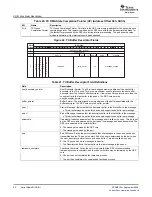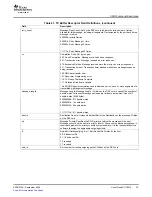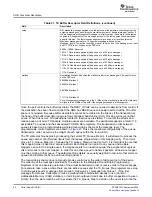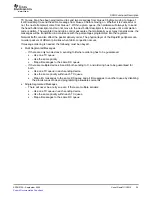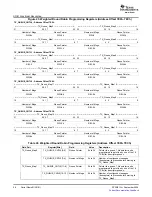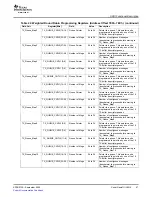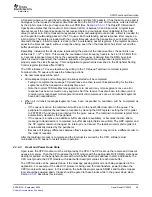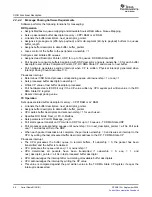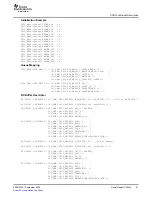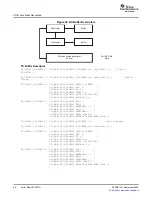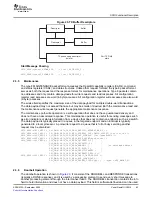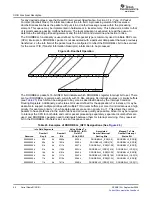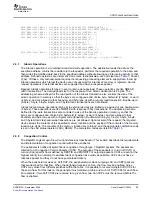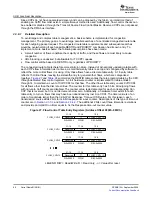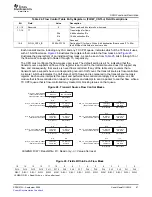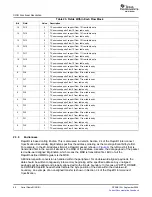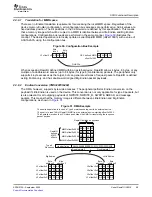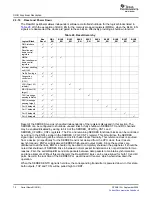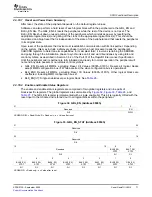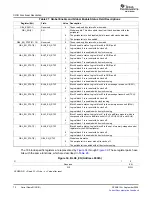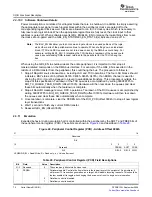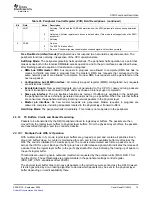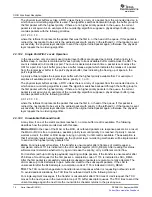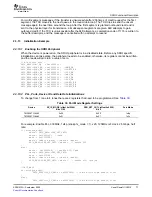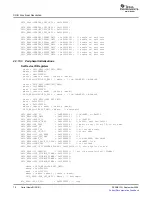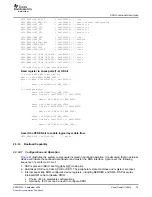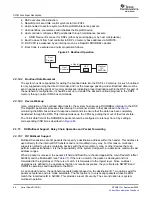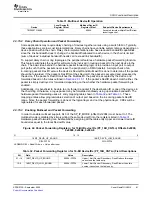
www.ti.com
2.3.8.1
Detailed Description
Reserved
FLOW_CNTL0
31-18
R-0x00000
TT
17-16
R/W-01
FLOW_CNTL_ID
15-0
R/W-0x0000
Reserved
FLOW_CNTL1
31-18
R-0x00000
TT
17-16
R/W-01
FLOW_CNTL_ID
15-0
R/W-0x0000
Reserved
FLOW_CNTL2
31-18
R-0x00000
TT
17-16
R/W-01
FLOW_CNTL_ID
15-0
R/W-0x0000
Reserved
FLOW_CNTL15
31-18
R-0x00000
TT
17-16
R/W-01
FLOW_CNTL_ID
15-0
R/W-0x0000
SRIO Functional Description
Since CCPs do not have guaranteed delivery and can be dropped by the fabric, an implicit method of
enabling an Xoff’d flow must exist. A simple timeout method is used. Additionally, flow control checks can
be enabled or disabled through the Transmit Source Flow Control Masks. Received CCPs are not passed
through the DMA bus interface.
To avoid large and complex table management, a basic scheme is implemented for congestion
management. The primary goal is to avoid large parallel searches of a centralized congested route table
for each outgoing packet request. The congested route table requirements and subsequent searches
would be overwhelming if each possible DESTID and PRIORITY combination had its own entry. To
implement a more basic scheme, the following assumptions have been made:
•
A small number of flows constitute the majority of traffic, and these flows are most likely to cause
congestion
•
HOL blocking is undesired, but allowable for TX CPPI queues
•
Flow control will be based on DESTID only, regardless of PRIORITY
The congested route table is therefore more static in nature. Instead of dynamically updating a table with
each CCP’s flow information as it arrives, a small finite-entry table is set up and configured by software to
reflect the more critical flows it is using. Only these flows have a discrete table entry. A 16 entry table
reflects 15 critical flows, leaving the sixteenth entry for general other flows, which are categorized
together.
Figure 27
and
Table 24
summarize the DESTID table entries that are programmable by the CPU
through dedicated flow control registers. A 3-bit hardware counter is implemented for table entries 0
through 14, to maintain a count of Xoff CCPs for that flow. The other flows table entry counts Xoff CCPs
for all flows other than the discrete entries. The counter for this table entry has 5 bits. All outgoing flows
with non-zero Xoff counts are disabled. The counter value is decremented for each corresponding Xon
CCP that is received, but it is not decrement below zero. Additionally, a hardware timer exists for each
table entry to turn on flows that may have been abandoned by lost Xon CCPs. The timer value is of an
order of magnitude larger than the 32-bit Port Response Time-out CSR value. For this reason, each
transmission source adds 2 bits to its 4-bit response time-out counter. Descriptions of this type of time-out
counter are in
Section 2.3.3.3
and
Section 2.3.4.2
. The additional 2 bits count three timecode revolutions
and provide an implicit Xon timer equal to 3x the Response time-out counter value.
Figure 27. Flow Control Table Entry Registers (Address Offset 0900h–093Ch)
LEGEND: R/W = Read/Write; R = Read only; -n = Value after reset
Serial RapidIO (SRIO)
66
SPRUE13A – September 2006
Submit Documentation Feedback

